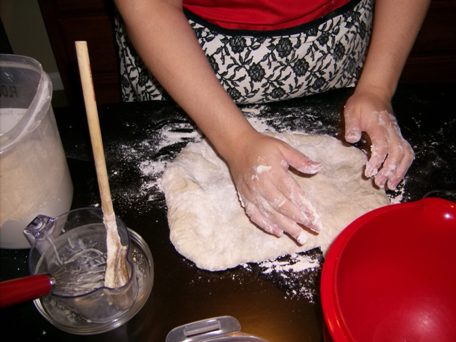One of the best wedding gifts my hubbilicious and I received was Beth Hensperger's The Bread Bible. After reading the introduction and first chapter, I decided to follow in Hensperger's footsteps and do what she did, twice: teach myself more about the craft and art of bread baking by baking every recipe in a bread book, in order. And so it began, on August 14th......
When I first opened the oven door, my heart sank. Surely, these loaves were far too brown. A quick tap on the upper crust of the left loaf yielded a reassuringly hollow sound, but also the discovery that the crust was, as feared, rock hard. Which would be great, if I had attempted an artisan bread, but I hadn't. This was white bread. It was supposed to be pillowly soft and offer an airy, slightly-sweet cushion for peanut butter and jelly or crisp up in a toaster into a perfect bed for melting butter. The warm, unmistakable smell of baking bread that had gently settled in the house like a blanket seemed almost mocking. I sniffed once while taking the loaves out of the oven; it didn't smell like burnt bread. Placing the loaves on the rack, I stood over them and fretted.
I laid them on their side, remember what I'd read about that way, the cooling would be even. My husband, meaning well, said, "Don't the crusts usuually soften up?" I was forced to reply with a grumpy, "Yes," not bothering to explain that most of the time, that wasn't a good thing.
So, I turned off the oven, returned to the couch where we'd been watching TV, and waited.
Or, at least I appeared to be waiting. What was really going on was a step-by-step analysis of what I had done.
Thinking about it, the formula had seemed a little strange to me, as the liquid base of honey, melted butter, water, salt and one single cup of flour seemed to create a batter similar to pancake batter. Maybe that wasn't what it was supposed to be like at all. Maybe that's where it all went wrong.

After adding the flour, using the maximum of the six cups stated in the recipe, I had turned to kneading. I remember thinking that although the dough was a bit sticky and difficult to shape, it did feel right by the end.

Once I coated it (using olive oil), I of course put it in a bowl to rise and covered it with plastic wrap. Normally, I use a damp towel to raise my dough, but I deferred to Hensperger's expertise. I found the rising to be very successful.

I really enjoyed shaping this dough, although I recalled that I had worked it quite a bit. Was the sponge going to be too dense and compact? The loaves hadn't felt heavy when I put them on the rack, but then again, I "dumped" them out rather quickly as the pans were, of course, hot. And what if the crust did soften? Didn't that mean the bread had gotten soggy? Wasn't that a bad thing....?
Perhaps my "lightly floured surface" was too floured. But honestly, it had really felt ok. I'm not a master baker by any means, or even an amateur one, for that matter, but I did generally trust my instincts when it came to baking my bread. The dough had been firm, pliable, perhaps a touch sticky but not too bad....heavy, but not dense.....flexible.....it had that wonderful earthy smell of clean yeast.....
And finally, they were put in the pans. I did know I felt the dough was a bit lumpy, but assumed it would kind of smooth out.

And then, of course, they had come out.
Unable to stand it anymore, I finally decided to just cut into the bread. I was terribly nervous. Flour wasn't getting any cheaper and, in a rather literal sense, I couldn't really afford to make too many learning mistakes. The bread hadn't quite cooled, but had that last layer of warmth that begs one to eat it.

To my relief, the crust had softened (this was not how I had felt when the same thing happened to my ciabatta last year; the irony did not escape me). The crumb looked much better than my worried mind might have otherwise made it.
In fact, the entire loaf looked, smelled, and felt wonderful. My sprits cautiously began to rise like yeast in warm sugar water. My husband, a fan of the heel, took the first bites. Hardly an objective reviewer, but I knew him well enough that I could watch his face and see how the loaf had really turned out.
He seemed to really, really enjoy it! I took a closer look at the crumb.

.....I tried a piece, putting a doomed pat of butter upon it. Took a bite and.....VICTORY!!! It was everything warm, fresh-baked bread should be. Soft, chewy, not soggy, and glorious in its simplicity. As promised, we gave a loaf to our neighbor from Poland, who said it reminded him of bread he got at home. A few days later, he made a point to tell me he enjoyed it. But I didn't need his compliments, appreciated though they were. I knew, because I had enjoyed perfect toast for the past three days.
- Shutzie27's Blog
- Log in or register to post comments
Congratulations on your success. There is always such a sense of achievement when you produce a loaf from your own kitchen. I think it is because it is something that we are just so used to buying from the bakery or supermarket that it feels quite remarkable when you do it on your own.
Syd